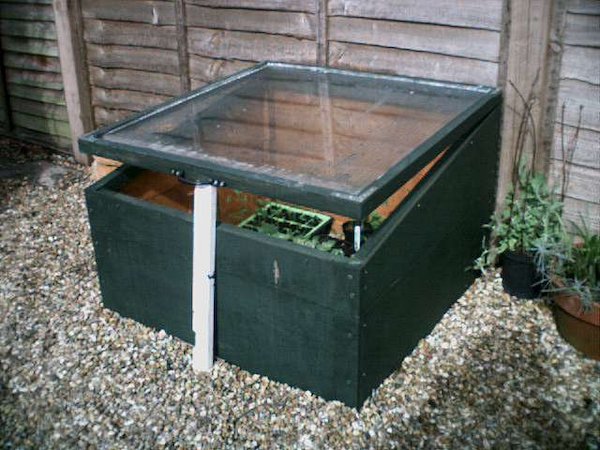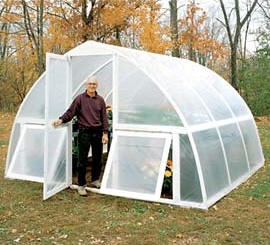Updated: November 19, 2020
When it comes to reusing windows in the garden, many people consider making a greenhouse or cold frame. But they don’t go through with it because it seems to be too big of a project.
Believe it or not you can make a greenhouse or cold frame if you are willing to invest a little time and effort, and not much money. The key is finding the right raw materials that ultimately will offer shelter for your plants.
For example, many people bring their seedlings outside or even put them in the ground too early in the spring. This results in stunted plants.
Some regions may have too short of a growing season to grow the vegetables they want. Or heavy rains, wind, and even animals can affect growing patterns throughout the summer.
Related: Fixing an Overflowing Rain Barrel
That’s why, for the novice or experienced gardener/craftsman, reusing windows in the garden can be the ideal solution for assembling small greenhouses that will give plants the extra protection they need.
Energy efficiency means windows are easier to find
Many homeowners are replacing wood windows or doing repairs in order to improve the energy efficiency of their homes. Old wood windows are fairly easy to find lying around sidewalks on trash day or at home renovation sites.
You can get good leads on old wood windows by calling local construction companies and asking where they are doing window work.
I know from firsthand experience that this achieves results. In many cases, contractors would be more than happy for you to take their “debris.”
Even in the cold of winter, the growing space will warm up to temperatures around 100 degrees Fahrenheit.
— Suburban Hobby Farmer
That said, before you go running around lugging windows home in the trunk, consider the details of the project.
How big do you want the greenhouse? Will you use it in winter.
This will dictate the quality and number of same-sized windows necessary.
But if you’re not sure yet which direction to pursue, here are a few project ideas to help get you started:
The novice approach to reusing windows in the garden:
Here is an idea for an easy-to-build, less complicated structure.
One window may be all you need to make a cold frame. For example, one window can easily be suspended over plants by resting the corners on various types of bases like cinder blocks, wood, bricks, or even plastic bottles filled with sand to give them weight.
Just make sure whatever you use is sturdy enough so the frame doesn’t fall over in a strong gust. These “temporary” shelters are easy to erect and disassemble and can be set up in the garden itself or other space like a patio.
Related: Winter Sowing Made Better. A Better Way to Grow in the Winter
Another easy option: dig a hole on a south facing hill and refill partially with good topsoil. Then take a window and cover the hole. You now have a very insulated cold frame.
You just need to be sure to have some way to easily let the hot air out. This is because on sunny days, even in the cold of winter, the growing space will warm up to temperatures around 100 degrees Fahrenheit.
The intermediate approach:
If your aim is to build a greenhouse-box or miniature greenhouse, it’s a little more complicated. Still, it’s not too difficult.
First, find at least five windows of the same size. Then, stand two on their side and placing a third over the top.

Extend the Growing Season
All my articles on hoop houses, cold frames, indoor growing, winter sowing and more!
Secure the top to the sides with screws and add a brace of some kind at the corners where both meet.
An optional step is to take a narrow strip of wood or other strong material the length of one open side and make a brace-like railing. This will provide better sturdiness.
Lastly, lean the two remaining windows against the respective openings. Don’t fasten them. This is so you can push them aside freely.
Now, you can put plants in and remove them with ease from your new greenhouse box.
For the more ambitious:
If you have taller plants that need protection or just want more protective, sturdy space, you could go a step further.

Here you will need at least eight windows. But, of course, it all depends on how big you want to make the greenhouse.
To start, stand three windows on their sides to make three walls of a house with no roof. After you securing them together with screws and braces, you must add another three on top of the lower ones. Ultimately, you will have the skeleton of a two story structure.
Then, secure the second floor to each other and the ones below. To finish, you need to make a roof using a window horizontally or two windows to make a peaked roof.
If you choose the peaked roof, seal the open sides with other material, different sized windows, or leave it wide open.
The decision depends on how energy efficient you want the structure. Often cooling the inside will be as much a problem as not enough heat.
One final note: Because some of the windows may not look very good, you’ll need to be creative and paint the frames different colors.
You can either match the surroundings or make it look totally out of place. Either way, it could have its appeal.
Related articles you might enjoy:
- A Hoop House is a Tomato Growing Machine
- Grow Millions of Cucumbers in a Hoop House
- Book Review: Eliot Coleman’s Handbook
- Better Tomatoes with Walls-O-Water Season Extenders
Suburban Hobby Farmer is a participant in the Amazon Services LLC Associates Program, an affiliate advertising program designed to provide a means for sites to earn advertising fees by advertising and linking to amazon.com.
